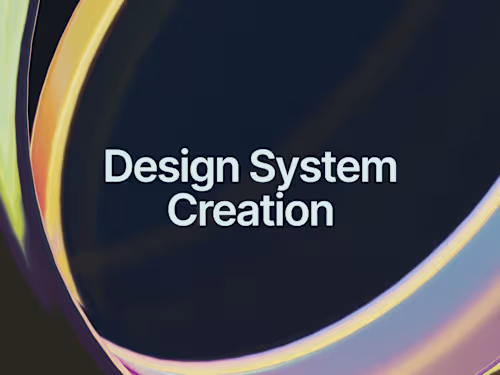
Design System Creation and Implementation
Contact for pricing
About this service
Summary
FAQs
1. What is your design process?
My design process starts with understanding the problem through research, user interviews, and gathering insights. I then move to wireframing and prototyping, focusing on creating intuitive, user-friendly experiences. After that, I design high-fidelity UI elements, conduct usability testing, and make iterations based on user feedback. I ensure that the design is both visually appealing and functional across platforms.
2. How do you ensure that your designs are user-friendly and accessible?
I prioritize user research, including usability testing, surveys, and persona creation, to ensure that my designs meet user needs. I also follow accessibility standards (WCAG) to ensure that the designs are inclusive for all users, including those with disabilities. I test designs across different devices and screen sizes to guarantee a seamless, responsive experience.
3. What tools do you use for UI/UX design?
I mainly use tools like Figma and Framer for UI design, wireframing, and prototyping. I also use Illustrator and other Adobe Creative Suite tools for high-fidelity graphics and assets. For collaboration and project management, I rely on Slack, Notion, and ClickUp to ensure smooth communication with clients and cross-functional teams.
4. How long does it take to complete a UI/UX design project?
The timeline depends on the complexity of the project. A simple website redesign might take a few weeks, while a mobile app design could take a couple of months. The process involves research, wireframing, design iterations, and usability testing, which can vary based on feedback and project requirements. I always work with clients to set realistic timelines based on their needs.
5. What sets you apart from other UI/UX designers?
What sets me apart is my combination of creative problem-solving and strong user-centered design principles. I have experience working across both B2B and B2C projects, which allows me to tailor designs to different user needs. I also bring a strong focus on accessibility and responsive design, ensuring that all users, regardless of ability or device, have a seamless experience. Additionally, I’m passionate about continuous learning and staying current with design trends and best practices.
What's included
1. Design System Documentation
Overview & Guidelines: A clear set of design principles, brand guidelines, and design rules that dictate how the system should be used and maintained. Usage Instructions: Detailed instructions on how to use components, UI patterns, and any relevant tools to implement the design system consistently
2. UI Components Library
Reusable Components: A collection of reusable UI elements such as buttons, forms, input fields, navigation bars, and other UI elements (often created in tools like Figma or Framer). Interactive Prototypes: Working prototypes of UI components that demonstrate their behavior, interaction states, and transitions.
3. Design Patterns
Layouts & Grids: Consistent grid systems, layouts, and design patterns that ensure structure across pages and screens. UI Elements Patterns: Guidelines for using certain components and patterns like forms, cards, tables, and buttons in different contexts to maintain consistency.
4. Color Palette & Typography
Color Scheme: A defined set of colors (primary, secondary, background, text) with usage guidelines for accessibility, contrast, and consistency. Typography: Defined typefaces, font sizes, line spacing, and typographic hierarchy that support readability and maintain visual consistency across platforms.
5. Iconography and Imagery Guidelines
Icons: A consistent set of icons (size, style, and usage) that can be reused across interfaces to enhance user experience. Imagery Guidelines: Instructions on how to use imagery, photography, and illustrations that align with the brand's visual language.
6. Responsive Design Guidelines
Breakpoints: Specifications for how the design should adapt and scale across different screen sizes (desktop, tablet, mobile). Responsive Components: How components and patterns should behave across various devices, ensuring that users have a seamless experience regardless of the platform.
7. Accessibility Guidelines
WCAG Compliance: Ensuring that all components and elements meet accessibility standards (e.g., contrast ratios, keyboard navigation, etc.). Inclusive Design Practices: Guidelines that ensure the design system can be used by people with different abilities, meeting both legal and ethical standards.
8. Version Control and Maintenance Plan
Version History: A document outlining different versions of the design system, highlighting key changes and improvements. Maintenance Schedule: A roadmap for updating and evolving the design system to adapt to new features, technologies, or user feedback.
9. Implementation Support
Developer Handoff: Deliver the necessary assets and documentation for developers, including code snippets, reusable components, and integration instructions. Collaboration with Development Teams: Provide ongoing support to ensure proper implementation and address any issues during the development phase.
10. Training and Onboarding Materials
Team Training: Training sessions for designers, developers, and other stakeholders on how to effectively use and implement the design system. Onboarding Guides: Step-by-step guides and resources for new team members to quickly get up to speed with using the system.
Recommendations
(5.0)

Client • Jun 19, 2025
Recommended
Laeticia created some very nice UI mockups for v3 of my app and was very impressed with her work!
Skills and tools
UX Researcher
UX Designer
UI Designer

FigJam

Figma

Framer
Industries
More services
